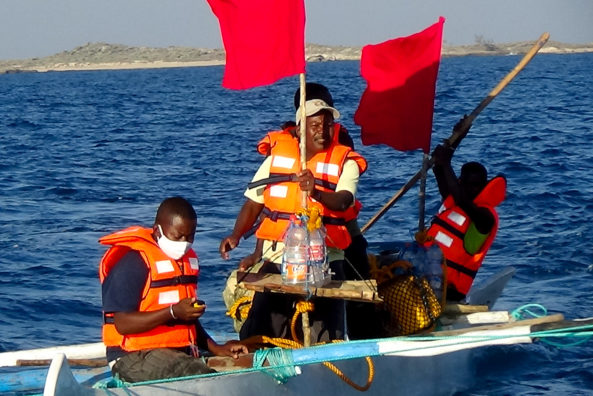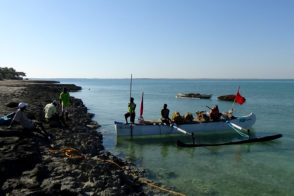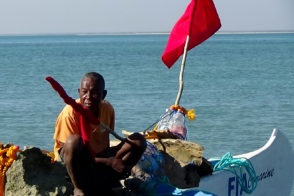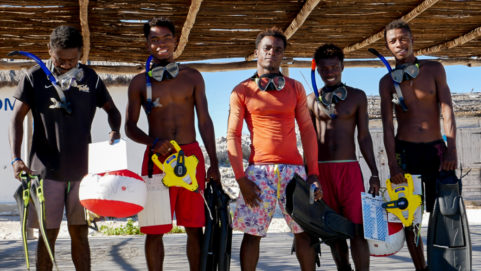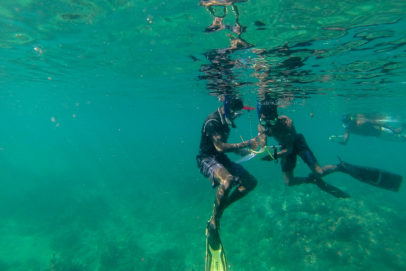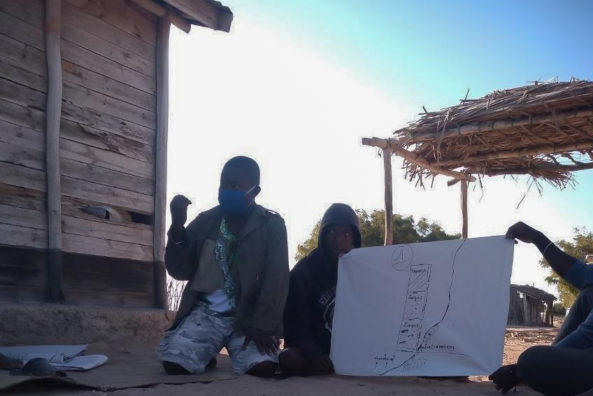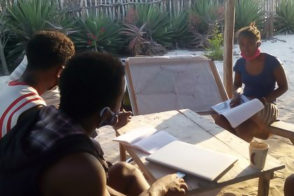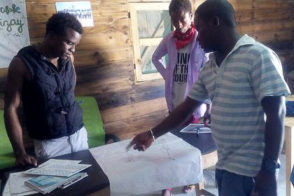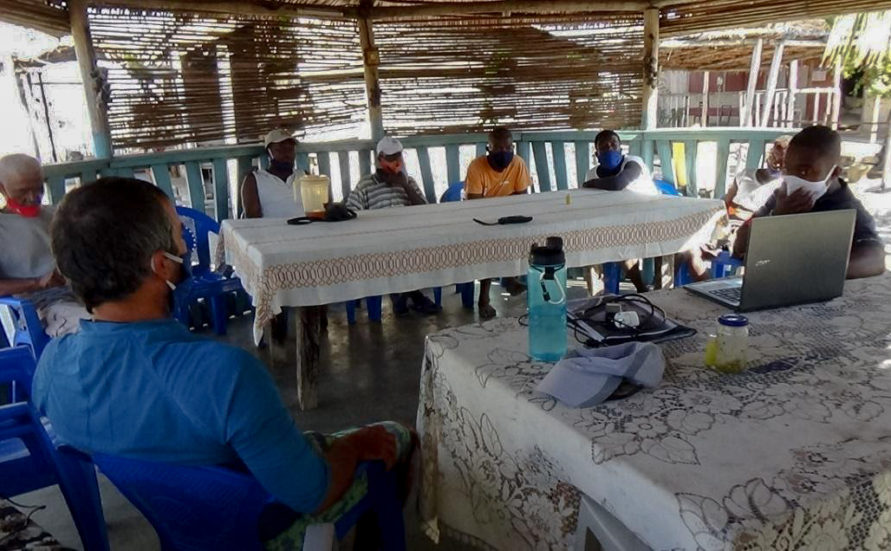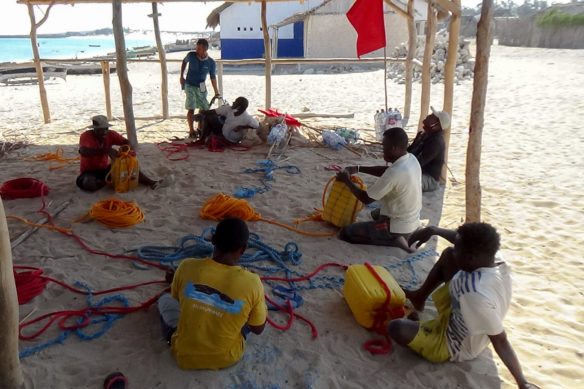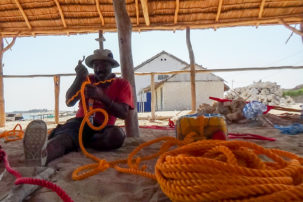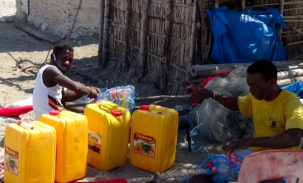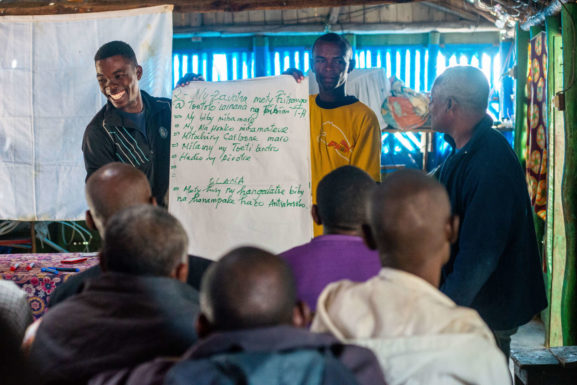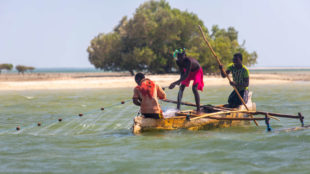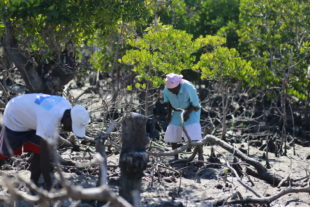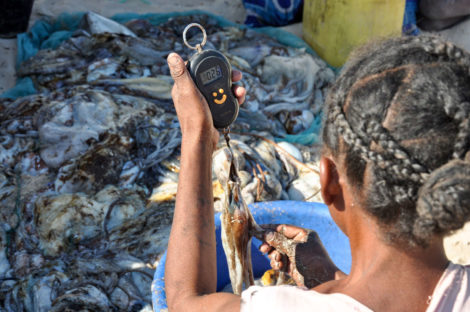In an era of global pandemics, climate breakdown and declining fish stocks, the challenges being faced by small-scale fishing communities are intensifying at an alarming rate. Yet, a small community association that manages the Velondriake Marine Protected Area (MPA) in southwest Madagascar, is showing a glimmer of hope for their community, for their fisheries, and for their future.
I first came across the Velondriake Association in 2012 whilst working for a Malagasy NGO, CITE, which was supporting Blue Ventures’ aquaculture programme within the MPA. After three years of training seaweed and sea cucumber farmers in business management and finances, I took on a new role at Blue Ventures as a Community Association Support Coordinator. I supported the locally led association in Velondriake to become more dynamic, to build engagement with the wider community and ensured transparency between Blue Ventures and the association.
I find myself transfixed by the impressive people-led marine conservation action that is happening right on my doorstep.Since then the locally managed marine area has achieved MPA status and I have also progressed to Regional Manager for southwest Madagascar. I oversee all of Blue Ventures’ work across the region, however, some recent activities in Velondriake have shifted my attention, and I find myself transfixed on the impressive people-led marine conservation action that is happening right on my doorstep.
With a new local diving ecological monitoring team and an increasingly engaged community of fishers, the Velondriake Association has successfully expanded their network of permanent no-take zones (NTZs – areas which are permanently closed to fishers in order to replenish fish stocks and protect biodiversity) by 59% (around 160 football fields) and have put in place a series of surface marker buoys using traditional techniques to mark out these new zones.
Whilst this may not sound particularly complicated, we have been working with the Velondriake Association to establish these buoys for many years, and as ever, there have been a number of challenges along the way. Firstly, most of our team worked on Blue Ventures Expeditions (BVE) so weren’t able to help out in the planning of the new buoys. Secondly, there was the age old problem of money – the large plastic buoys that we had planned to install were expensive and had to be shipped from overseas. Lastly, the proposed technique for setting the buoys was complicated – the anchors were large cement blocks that required SCUBA diving to install. These buoys had been used in the past in Velondriake and there had been numerous instances where the ropes had broken from tension caused by strong currents and the weight of the buoy itself. These frequent breakages meant frequent (and expensive) reinstallation, only to see the same problems emerge later down the line.
In an odd twist of fate, the COVID-19 pandemic resolved our people-power problem; after Blue Ventures’ Expeditions were put on hold, we began training community members to collect ecological data on the reefs of Velondriake (this was previously done by trained BVE volunteers), which in turn created a local team of marine conservation experts who could input into the NTZ expansion plans.
Combining their newfound scientific understanding with their traditional knowledge of the reef had a huge impact on the plans.Combining their newfound scientific understanding with their traditional knowledge of the reef had a huge impact on the plans. In fact, it was Jacks, the eldest member of the team, who supported decision making on the size of buffer zones (transition areas surrounding a reserve that help to minimise the effects of any outer pressure) around the NTZs. Initially, our team had suggested a 25 metre buffer zone, but during consultations with communities across Velondriake, one fisher, Bruno, told us that if he wanted to he could anchor his pirogue on the edge of the reserve and cast his line into it to fish.
Through their science training, Jacks and the team knew that this causes the fish to move into the centre of the NTZ to avoid the fishing lines, meaning that they can’t spawn as abundantly (known as the ‘edge effect’). Jacks came up with a helpful analogy so that community members could understand this technical concept,
Communities have to look after their marine resources just as they look after their ducks. They know that their ducks have to be free to lay more eggs, they need more space around to find a partner and mate. The same happens with fish, they need larger reserves to be as productive as their ducks.”
Bruno’s input and Jacks’ analogy sparked discussions among the communities, and our original suggestion of a 25 metre buffer zone was rejected. Along with his science team, Blue Ventures staff and a few members of the association, Jacks presented options for the buffer zones (either 25, 50 or 100 metres) in a number of villages, and it was the communities themselves who concluded that a 100 metre zone would be the best way to protect their fisheries.
Discussions like this one happened in our recently established meetings with the Velondriake Committee, which happen every two weeks. Although our association support team had always met regularly with the committee, Blue Ventures’ managers (including site leaders like myself and some of the programme coordinators) couldn’t always take part, often just receiving feedback after meetings.
Now, with everyone on board (some of us joining virtually via Google Hangouts, much to the amusement and amazement of the community members!) we are able to marry the technical knowledge of the Blue Ventures team with the local understanding of the community, to enable them to come up with their own solutions for fisheries management.
With the bi-weekly meetings providing newfound opportunities for collaboration, the association was able to carefully draft out plans for the expansion of their NTZ network that represented their needs. After one of our meetings, I asked Jacks why he had inputted,
I shared ideas on the extension as I thought that if we left the NTZs as they were, it would not be enough and there would not be enough space for the fish to grow” he said.
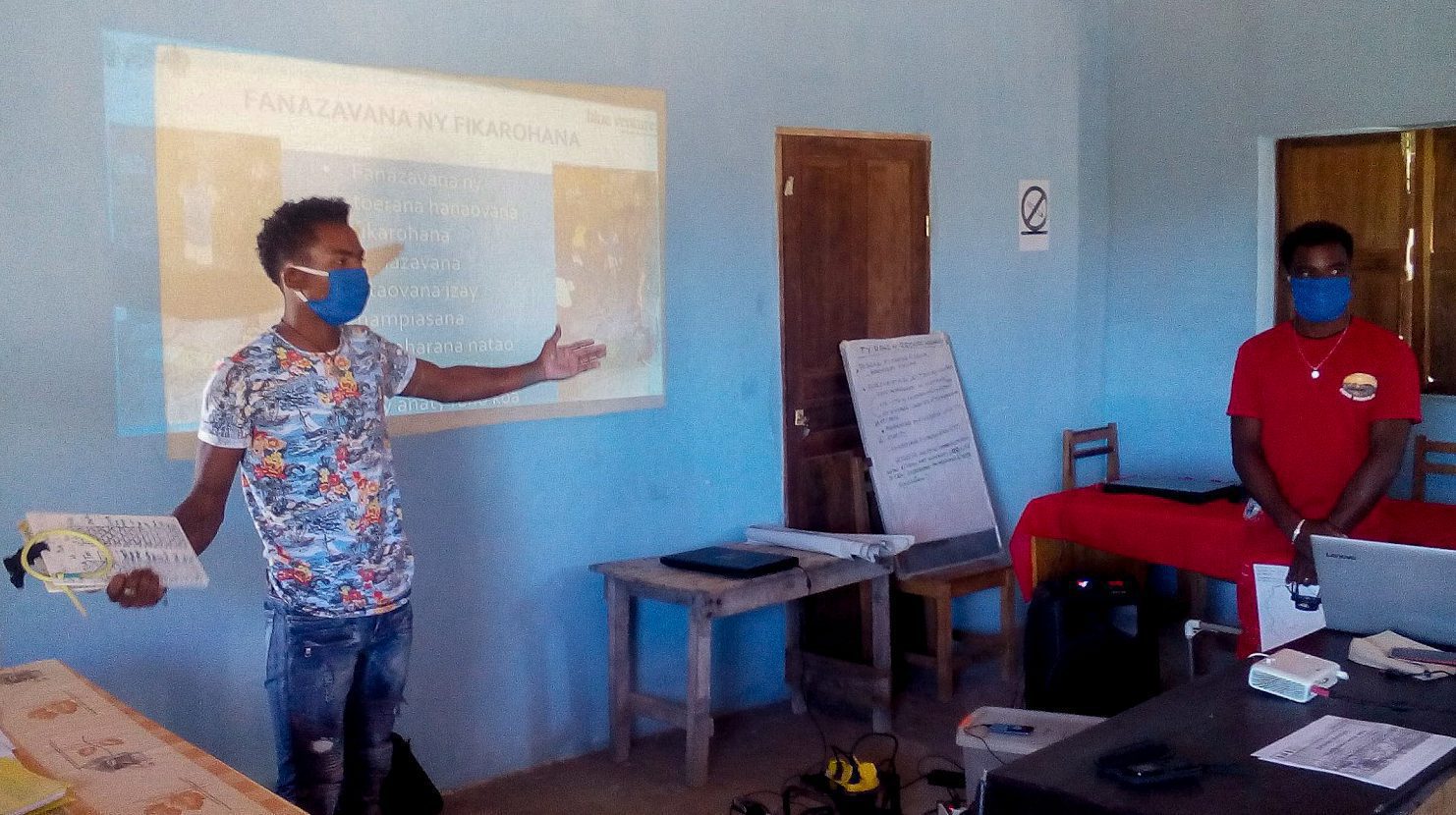
Ronaldo and Patin (community monitoring team) present at the bi-weekly Velondriake Association meeting | Photo: Javier del Campo Jimenez
During one of our meetings with the committee, we shared this problem and it didn’t take long for the community members to suggest a local solution.It was also during these meetings that the community came up with a solution for the buoys. As I mentioned, the original plan was to install buoys shipped from overseas – this was not only going to be expensive, but it also required specialist installation. During one of our meetings with the committee, we shared this problem and it didn’t take long for the community members to suggest a local solution.
Ratsimbazafy Clain, the Treasurer of the Velondriake Association, told us that back in 2015 the community had trialled a different buoy method, as the large plastic buoys’ ropes kept breaking. These buoys utilised locally sourced materials; a 20 litre vegetable oil can as the main part of the buoy, a bundle of empty 1.5 litre soda bottles to reinforce the flagpole, some fishing rope and a large rock on the seabed to anchor the buoy in place – the ropes were tied using a traditional fishing technique called jarifa.
Ratsimbazafy said that the jarifa method was simple, easy to maintain, easy to replace and most importantly, didn’t seem to move or break in the large swells and strong winds that batter the shorelines here. We had found our solution.
My colleague Javier, who is involved in training the new local ecological monitoring team, worked with the community to set the new buoys in place. Due to COVID-19, they weren’t able to SCUBA dive, but thankfully, a few of the team and some other community members are skilled spearfishers, meaning that they were able to free dive up to 30 metres down to the seabed to check the heavy rock bases of the buoys weren’t damaging any coral. Yet again, the community’s lifelong experience with the ocean meant that they were able to play a leading role in establishing the NTZ expansions.
This local knowledge also helped us to work with the community to ease out a few teething problems in the early stages. During the drafting phase, the association visited a number of villages across the NTZ network to present their plans. Mostly, the communities were satisfied, but in the village of Bevato, the planned extension of their NTZ, Ambatohalaombe, spilled over into a reef flat where fisherwomen glean octopus. The community simply said, “if you want to extend it, do it in a way that won’t affect our livelihoods”. The Blue Ventures team visited the community in Bevato not long after to show them some alternative options; we worked together with the octopus gleaners to create a solution that met everyone’s needs.
This was a powerful reminder that in community conservation, we must listen to communities in order to get the balance right.This was a reminder that in community conservation, we must listen to communities in order to get the balance right. Of course, the hope for these larger NTZs in Velondriake is to increase fish biomass (the total weight of fish in an area), replenish fish stocks and give damaged reefs time to recover, but what about the people who rely on these marine areas for their survival? They still need to be able to fish so that they can provide for their families, yet, on the other hand, without protection their fisheries will continue to decline and their children and grandchildren may not have the same livelihood opportunities that they do.
Conservation solutions need to respond to both environmental and socioeconomic needs, which is why community-led efforts can be so effective. But raising awareness of the environmental need for marine protection among small-scale fishing communities takes time, patience and most importantly, evidence that conservation is in the best interest of the community, as well as the planet.
The community needs to take part in marine conservation so that they know what their future will be, and the future of generations to come. If the ecosystem is damaged that will have an effect on both community life and marine life.” – Jacks
Community awareness raising has to be done by the community and local leaders who are trusted and respected. In Velondriake, not only are there now community-based data collectors who can feedback these data, but there are also strong leaders in place who understand first-hand the challenges faced by fishers in their community and who are passionate about protecting their fisheries. Ratsimbazafy, who is one of these strong leaders, told me that he hopes that the new NTZ expansion will lead to, “further protection of seagrass and mangroves as those areas should be extended as well – all of it is linked”.
The Velondriake Association is increasingly independent – they lead their own meetings, manage their own finances (which they have recently used to build five new multipurpose buildings in the Bay of Assassins) and implement their own conservation plans, from mangrove restoration to fisheries management. I’m so impressed by how proactive and engaged they are becoming, only relying on Blue Ventures for logistical support, sharing data and technical expertise.
[Taking part in marine conservation] is like protecting your own household, if we do marine conservation our livelihoods won’t be damaged. The community here now understand the importance of marine conservation.” – Ratsimbazafy
Over the years, if there is one thing I have learnt about community-led conservation, it’s that the more the community do it themselves, the more positive the results are. Here in Velondriake, the recent NTZ expansion is a demonstration of that lesson. From suggesting ideas to extend the buffer zone and negotiating with local fishers on the placement of the buoys, to diving beneath the waves to physically put their handcrafted buoys in place, the community here have taken ownership over this important step in their journey to protecting their fisheries.
Despite the unfolding challenges they are up against, this community’s hope for the future seems stronger than ever as they continue to craft safety nets for themselves in the form of locally led marine conservation. This same hope reminds us why putting communities first in the fight against climate breakdown, COVID-19 and the other global shocks that we continue to face, is the only way to secure a sustainable future for our oceans and our planet.
Learn more about the new local diving ecological monitoring team in Velondriake


